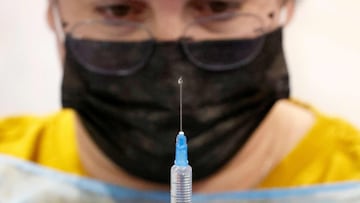Covid-19 vaccine in the US: who can get it and requirements
The US started its covid-19 vaccine program for priority groups on 14 December with around 2.6 million people receiving a shot as of 31 December.

As vaccine programs are rolled out worldwide in a bid to break the back of the coronavirus pandemic as 2020 makes way for 2021 in what people across the globe hope will mark the beginning of the end of social and economic uncertainty, the question on many people’s minds with a new, potentially more transmissible variant of the virus recently being identified, is when a line can be conceivably be drawn under the covid-19 crisis.
The World Health Organization stated recently that covid-19 could become endemic and the world population may have to learn to live with the virus. “The likely scenario is the virus will become another endemic virus that will remain somewhat of a threat, but a very low-level threat in the context of an effective global vaccination program,” The head of the WHO emergencies program, Dr Mike Ryan, told a press conference on 28 December.
Meanwhile, Tedros Adhanom Ghebreyesus, WHO director-general, marked a year since the emergence of the first reported cases of coronavirus in China by urging the world to pull together to ensure that no country is left behind in the scramble for vaccines.
“Vaccines offer great hope to turn the tide of the pandemic. But to protect the world, we must ensure that all people at risk everywhere - not just in countries who can afford vaccines - are immunised,” the WHO director-general said, calling on $4 billion to be pumped into the COVAX vaccine facility to ensure distribution in lower and middle-income countries.
Eligibility for a vaccine in the US
In the US, healthcare and frontline essential workers, care home residents and people over the age of 75 have been made priority groups for vaccination. Healthcare personnel and people in care homes on a long-term basis are classified as Phase 1a with frontline essential workers and the over-75 age group in the Phase 1b bracket.
Phase 1c covers people in the 65-74 year-old age group, 16-64-year-olds with underlying medical conditions and other essential workers.
From there, states will decide on their own vaccination programs, under guidance from CDC recommendations.
Around 2.6 million US citizens have received a vaccination against covid-19 as of 31 December, according to figures released by federal officials on Wednesday. About 14 million doses of Pfizer's and Moderna's vaccines have been distributed to states so far, shy of its goal to ship 20 million doses this month.
US vaccinations of the country's 21 million healthcare workers began on 14 December. Inoculations of the country's 3 million nursing home residents started shortly afterwards.
Some 51 million US frontline essential workers, like fire fighters, police, and teachers, as well as people over 75 should be next in line to receive a vaccine, a CDC advisory panel has recommended.
"The Federal Government has distributed the vaccines to the states. Now it is up to the states to administer. Get moving!" US President Donald Trump tweeted.
US vaccination program underway
FACT: #COVID19 vaccination helps keep you from getting COVID-19.
— CDC (@CDCgov) December 28, 2020
The vaccines currently available in the U.S. are more than 90% effective at preventing COVID-19, according to clinical trials, and are important tools to stop the pandemic.
Learn more: https://t.co/KL3fJrcjsG. pic.twitter.com/WAkti62c0X
As late as early December, officials maintained they would have 40 million doses available this month, enough to vaccinate 20 million Americans with a two-dose regimen.
On 4 December, FDA Commissioner Stephen Hahn told Reuters that vaccinating 20 million Americans by year-end was realistic, depending on the vaccination campaign.
"The rapid availability and distribution of so many doses – with 20 million first doses allocated for distribution just 18 days after the first vaccine was granted emergency use authorization – is a testament to the success of Operation Warp Speed," a US Department of Health and Human Services spokesperson said in a statement.
The government has said that for every dose shipped, it is keeping a second dose in reserve as well as a safety stock, which would bring the total number of vaccine doses closer to 40 million.
Even as the number of doses distributed neared the goal of reaching 20 million people, the pace of actual vaccinations has been far slower than anticipated, according to data released by the Centers for Disease Control and Prevention.
Related stories
Local public heath officials told Reuters that the lack of federal funding for vaccine distribution has prevented them from hiring needed staff.
"We know that it should be better and we are working hard to make it better," Operation Warp Speed chief adviser Dr. Moncef Slaoui said on a media briefing.

